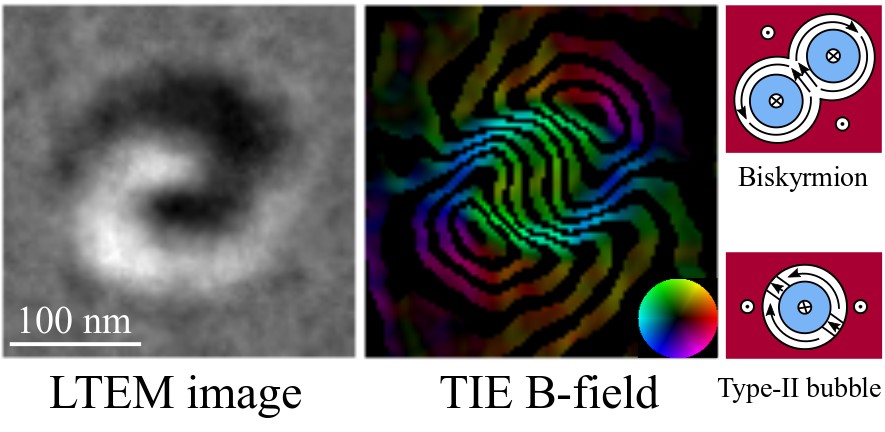Magnetic skyrmions resemble magnetic vortices and arise because of the competing interactions that occur in certain magnetic materials. They were discovered in 2009 and this has prompted an intense research effort as they could be used as magnetic bits for a new type of computer memory, called a racetrack memory. Unlike a conventional hard-drive, a racetrack memory has no moving parts and bits are moved along a wire by an electrical current. Skyrmions are attractive for this application because they can be moved by currents a million times smaller than those required to move ferromagnetic domains.
Skyrmions can be imaged using transmission electron microscopy and appear as white circles when the magnetisation is rotating in one direction and black when it rotates in the other. Recently, images have been published showing magnetic objects that appear half white and half black like the one in the figure. These were identified as a new magnetic object called a biskyrmion which consists of a pair of counter-rotating magnetic vortices. We searched for biskyrmions using a combination of electron microscopy, x-ray holography and micromagnetic simulations. This showed that there is no evidence that the biskyrmion state exists. The images can be explained as conventional magnetic bubble domains and the counter-rotating vortices result from the magnetic flux density associated with this object, not the magnetisation.
Image caption: The image on the left was taken from MnNiGa using Lorentz transmission electron microscopy (LTEM) and the central image shows magnetic field lines (B-field) calculated from a series of such images. Two counter-rotating vortices can be seen which led to this object being identified as a biskyrmion, sketched in the top right panel (arrows show the magnetisation direction). In fact, the images in can be explained as a conventional type-II magnetic bubble, sketched in the lower-right panel. The counter-rotating vortices do not occur in the magnetisation but result from the magnetic flux density (B-field) associated with this object.
J. C. Loudon, A. C. Twitchett-Harrison, D. Cortés-Ortuño, M. T. Birch, L. A. Turnbull, A. Štefančič, F. Y. Ogrin, E. O. Burgos-Parra, N. Bukin, A. Laurenson, H. Popescu, M. Beg, O. Hovorka, H.Fangohr, P. A. Midgley, G. Balakrishnan, and P. D. Hatton, "Do Images of Biskyrmions Show Type-II Bubbles?", Advanced Materials 31 (2019) 1806598

